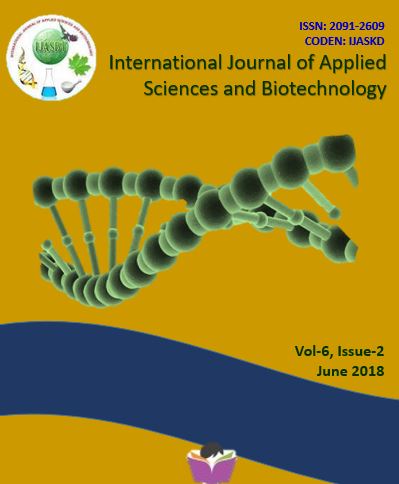Quantification of Phytochemicals Imparting Antioxidant Activities in Commonly Used Vegetables
DOI:
https://doi.org/10.3126/ijasbt.v6i2.19636Keywords:
Phytochemicals, Antioxidant, Free radicals, Lipid peroxidation, DNA damageAbstract
Plant derived phytochemicals have recently became of great importance in the protection of various diseases, like heart disease, cardiovascular disease, cancer, diabetes, Alzheimer’s disease, cataract and age related functional disorders caused by free radicals. The present study was carried out to explore the commonly used vegetables having higher content of antioxidant imparting phytochemicals such as ascorbic acid, carotenoids, total phenolic content, carbohydrate and protein content in commonly used vegetables. The results revealed that the concentration among tested samples ranged from 7.07 mg/100g of FW (Momardica charantia leaf) to 174.15 mg/100g of FW (Allium sativum leaf) for ascorbic acid; 1.31 µg/g of FW (Chenopodium album leaf) to 14.00 µg/g of FW (Allium sativum leaf ) for carotenoid content; 8.72 mg of GAE/g of DW (Cucurbita maxima fruit) to 67.20 mg/g of DW (Colocasia esculentum leaf) for total phenolic content; 27.15 mg/g (Laginaria vulgaris leaf) to 901.00 mg/g (Cucurbita maxima fruit) for carbohydrate content and 35.96 mg/g (Amarphophyllus fruit) to 589.23 mg/g (Beta vulgaris fruit) for protein content. Results also showed that these bioactive phytochemicals are widely distributed in the vegetables and their concentrations are variable in different vegetables as well as vegetable part’s itself. Hence, vegetable rich diet having higher content of phytochemicals can be used to cure or in the prevention of various chronic diseases such as hepatotoxicity, diabetes, cardiovascular diseases, cancer, oxidative stress etc and may serve as a good source of nutraceuticals which have potential for use in health care formulations.
Int. J. Appl. Sci. Biotechnol. Vol 6(2): 97-102




